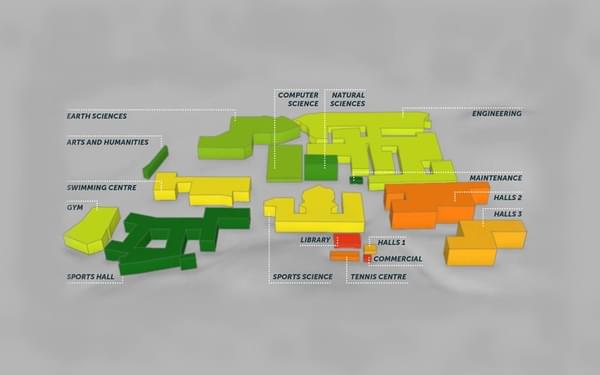Healthcare's twin challenge
PFI hand-back and decarbonisation

“ Seven years out from PFI expiry, estate teams need to be reviewing the condition of their assets, and through the lens of decarbonisation. ”
Mark Walker
Director, MEP Healthcare Sector Lead

The acute need for the NHS to decarbonise its estate - part of its Green Plan - holds the key to diffusing a further challenge - the expiry of PFI contracts which are consuming vast proportions of NHS budgets due to high interest rates and rising inflation.
Classified under the Department for Health and Social Care (DHSC), there are 140 listed PFI-funded projects in England alone with a future contract expiry date. Most expire before 2050, with repayment costs steadily increasing the nearer they reach expiry, impacting NHS budgets still further.
It's part of an overall ticking time bomb in terms of managing the costs and hand-back of these public serving assets. But, for the NHS - and the public sector as a whole - the equally important requirement to both decarbonise and adapt their facilities in the face of climate change, offers a path to securing hand-back in a state that's fit for the future. It also enables PFI providers to exit with a demonstrable narrative for their investors on how they helped the UK on its path to net zero.
Win-win. Yes, it's possible. But, the preparation starts now, and as always, it's all about data and understanding your assets.
The rising cost of PFI
In financial year 2022/23 the, annual PFI repayment for the NHS, including 'local' PFI hospital contracts, was £2.37bn. In 2001/02 it was £172m.
The peak for repayment isn't reached until 2031/32 when it hits £2.76bn a year. Most contracts expire in the late 2030s / early 2040s.
It's worth a quick step back in time. The Private Finance Initiative (PFI) was initiated as long ago as 1992 by the Conservatives and expanded by Labour. PFI uses private money for major public sector capital projects. The private company finances the design, construction and maintenance, and owns the facility, which is then leased back to the state in exchange for regular repayments. When the contract expires, the asset is handed back.
Across England, Wales and Scotland, there are 154 hospitals and acute health facilities that have had projects built under PFI. The challenge is, given the length of the payback terms, projects cost several times their capital costs in repayments.
Let's take a real-life example of a £46m capital cost project delivered over two years for a leading, well-known hospital. This project completed in 2006 and then began a 30-year repayment contract. On the Trust's balance sheet under International Financial Reporting Standards (IFRS), the first unitary annual charge payment was £8.6m. This figure rises to £30.5m by 2035/36, and in total the outlay will be £643m by the time the PFI contract expires.
Given those eye-watering figures, making sure the asset is handed back in the appropriate condition as stated in the contract, is essential to all parties to ensure everyone's reputation is intact.
PFI hand-back checklist
Before the clock runs down, NHS Trust leadership teams need to understand the contractual obligations on their PFI provider for the hand-back of their built assets.
Our advice is to start understanding the condition of the buildings at least seven years ahead of the expiry of the contract - agreeing defects to be rectified, securing planning, appointing advisors and contractors all eats time. And every one of these buildings is a live, operational asset, so disruption also has to be accounted for.
A 'Condition Ranking', as outlined by the Department of Health in their risk-based methodology for establishing and managing backlog, will be required to establish the quality of the built asset.
The goal is a 'B' rating - sound, operationally safe, minor deterioration. The evidence, demonstrated by the £10.2bn maintenance backlog highlighted in the sector's Estates Returns Information Collection (ERIC) return, is that many buildings are at C or even D level. Legacy performance issues are rife, and major repair and replacement schemes will be needed.
The huge figure attributable to the maintenance backlog (which accounts for England only) are costs associated with property occupied at all Trust sites, irrespective of ownership.
Our advice is:
- Confirm the legal requirements of the hand-back.
- Understand what your current scheduled maintenance programmes will achieve.
- Appoint a building surveyor and engineer to verify your buildings and plant.
- Instruct a specialist fire engineer to assess fire compartmentation against new regulations.
- Use an energy specialist to advise on opportunities for energy efficiency and decarbonisation.
- Understand how to access publicly available grants for decarbonisation works.
- Agree with PFI provider how issues will be fixed to meet contractual requirements.
- Use the NHS SBS Framework to secure the most appropriate delivery supply chain.
- Manage access to minimise disruption to live environments.
- Review all planned works and contracts.
- Maintain a digital record of all works and performance as a future baseline.
- Certify that all criteria for hand-back is met.
- Put in place forward maintenance plan.

Decarbonisation objectives - perfectly aligned to roadmap for PFI hand-back
The NHS has a publicly stated ambition to reduce the emissions they control directly by 80% in the period 2028-32. It's part of the overall goal to be net zero by 2045 for the emissions they can influence - NHS Carbon Footprint Plus.
This timeline aligns with the hand-back of a significant number of PFI-held assets. This fact was not lost on the Infrastructure and Projects Authority (IPA) who in July 2023 published a handbook of recommendations for the decarbonisation of operational PFI projects.
As part of a suite of papers, the IPA is supporting public sector PFI contract managers, and those responsible for meeting decarbonisation commitments for public sector buildings delivered through PFI, with practical advice on how to structure a decarbonisation roadmap.
There is recognition of the very rigid long-term contractual commitments which make it complex to change the assets, systems and operations delivered by PFI contracts. However, the IPA is offering advice on how to change contracts and encouraging public and private sector partners to work together.
A critical part of decarbonising the built environment is reducing operational carbon - energy consumption in the operation, maintenance, repair, refurbishment and use of the asset.
If preparation for PFI hand-back starts with understanding the condition of each built asset, then this is the perfect moment to establish a baseline conditions and efficiency audit, and to agree a programme of improvements that work contractually and deliver far better carbon and cost efficiencies for the long-term. Essentially, make every kWh count.
This auditing process is also a prime opportunity for each NHS Trust to establish the long-term risks from climate change to their estates. This will include both the likelihood and resulting impact on the estate from flooding, heat and wind. Climate adaptation planning to prepare an estate for greater resilience and security over the next 20-40 years, starts now.
Relevant decarbonisation funding streams for the NHS
Funding streams are available. Specifically, the government has allocated £6m to the decarbonisation of PFI projects, while Phase 3c of the Public Sector Decarbonisation Scheme (PSDS) has up to £230m available in 2024/25 which NHS Trusts can take advantage of so long as they have projects that are fully scoped and are 'fund-ready',
ERIC data from 2021/22 shows that 26% of NHS Trusts have declared a 'heat decarbonisation plan' which is an encouraging base to build on. The scale of the challenge though is also revealed in the ERIC data which reveals that 66% of NHS Trusts' derive more than three-quarters of their energy consumption from gas, oil and coal.
The sheer size and power requirements of a health estate lend NHS Trusts to be an 'anchor' for a heat network to which other users in the local area connect. The Department for Energy Security & Net Zero has a funding pipeline of £2.3bn for heat networks.
It's a win-win. The NHS has the opportunity to improve the operational and cost efficiency of their estate and meet their public goals to decarbonise and be a truly socially conscious organisation. PFI providers, all mainstream, large organisations backed by major investors, can walk away with ESG goals met from using their influence to revolutionise our much-vaunted public health service.
[Figures quoted are for England only unless otherwise stated]





















